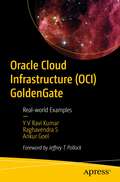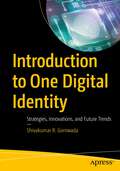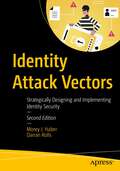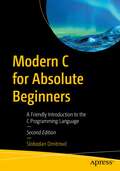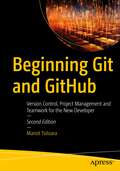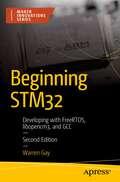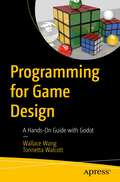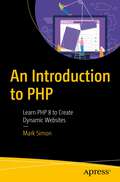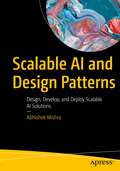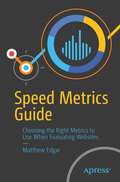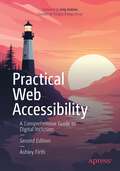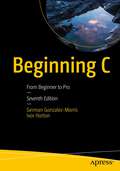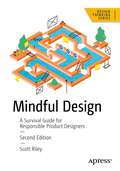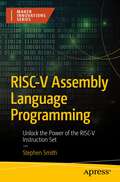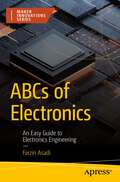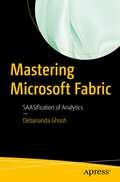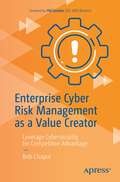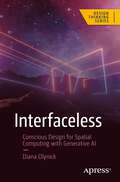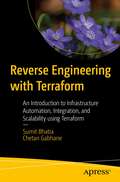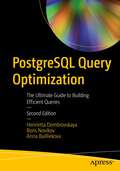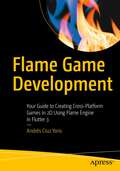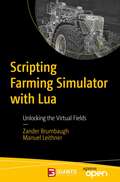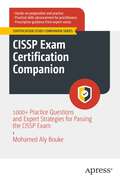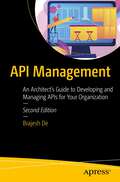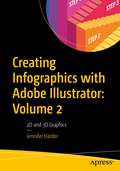- Table View
- List View
Oracle Cloud Infrastructure (OCI) GoldenGate: Real-world Examples
by Y V Ravi Kumar Raghavendra S Ankur GoelThis book focuses on the utilization of GoldenGate Services (GGS) in conjunction with a microservices architecture on the Oracle cloud (OCI), primarily for data migration and integration across various data sources and targets.The book begins with a practical example of utilizing GGS on a Marketplace VM, progressively advancing to in-depth discussions on implementing GoldenGate as a Service on OCI. The book offers illustrative guides for data replication between RDBMSs (such as Oracle, Postgres, and big data targets such as Kafka). Additionally, it explores monitoring techniques using Enterprise Manager and Grafana dashboards. A comparative analysis is presented between traditional VM-based GoldenGate installations and the OCI service model. Special attention is given to Zero Downtime Migration (ZDM) and leveraging GGS for database migration from on-premises to OCI. Some chapters address multi-cloud replication using OCI GGS and include real-life case studies.By the end of this book you will have gained comprehensive insights into the architectural design of GoldenGate Services and will be adept at replicating data using GGS, enabling you to replicate setups in your own environments.What You Will LearnSet up GoldenGate Services for high availability (HA), disaster recovery (DR), migration of data to cloud, and moving data into the data lake or lakehousePerform logical migration of data to the cloud using the ZDM tool (ZDM uses GoldenGate internally).Replicate data to big data targetsMonitor GGS using Enterprise Manager and GrafanaReplicate data in a multi-cloud environment Who This Book Is ForOracle database administrators who want to replicate data or use Oracle GoldenGate Services for migration and setup of high availability (HA) and disaster recovery (DR); and data engineers who want tobuild the data warehouse, data lake, data lakehouse to push data in near real-time
Introduction to One Digital Identity: Strategies, Innovations, and Future Trends
by Shivakumar R. GoniwadaExplore the dynamics of digital identity, a crucial component in today’s modern technology-driven era. This engaging book offers a deep understanding of how digital identity is evolving rapidly, why it’s so significant, and offers organizations, regulatory bodies, and academicians the strategies needed to adopt secure decentralized digital identity features effectively. It’s a must-read for those aiming to grasp the intricacies of digital identity and leverage it for future innovation and security.The book begins by redefining digital identity, examining its evolution and the profound impact it has on both individuals and organizations. It then delves into the development of digital identity strategies, laying the foundation for future digital transformations. Covering a wide range of topics, the book discusses the innovation, challenges, and technological exploration in digital identity. A special focus is given to biometric technologies and the implementation of decentralized digital identities, addressing critical areas such as identity governance, blockchain, AI and advanced biometrics. The book also investigates the implications of digital identity across various industries, including cross border travel, healthcare, social media, finance, metaverse, IoT etc. finally the book provides not only emerging trends but offers a glimpse into the future digital identity. Whether you’re a tech professional, business leader, student or simply keen on understanding the impact of digital advancements, this book promises to offer insightful perspectives and practical solutions for navigating the complex world of digital identity. It underscores the importance of identity in spearheading digital innovation, making it a key resource for anyone looking to stay ahead in the digital landscape. As you reach its conclusion, you’ll be equipped with a wealth of knowledge and insights that are crucial in today’s digital era.What You'll LearnDigital identity strategies and their role in shaping the future of digital identityDifferent facets of digital identitySpecifics of biometric technologies and decentralized digital identity Industry specific digital identity and its implementationCrucial aspects of privacy, ethics, and secure in the context of digital identityWho This Book Is ForSoftware professionals, security practitioners, architects, senior managers, executives, and students who are interested in digital identity.
Identity Attack Vectors: Strategically Designing and Implementing Identity Security, Second Edition
by Morey J. Haber Darran RollsToday, it’s easier for threat actors to simply log in versus hack in. As cyberattacks continue to increase in volume and sophistication, it’s not a matter of if, but when, your organization will have an incident. Threat actors target accounts, users, and their associated identities—whether human or machine, to initiate or progress their attack. Detecting and defending against these malicious activities should be the basis of all modern cybersecurity initiatives.This book details the risks associated with poor identity security hygiene, the techniques that external and internal threat actors leverage, and the operational best practices that organizations should adopt to protect against identity theft, account compromises, and to develop an effective identity and access security strategy. As a solution to these challenges, Identity Security has emerged as a cornerstone of modern Identity and Access Management (IAM) initiatives. Managing accounts, credentials, roles, entitlements, certifications, and attestation reporting for all identities is now a security and regulatory compliance requirement. In this book, you will discover how inadequate identity and privileged access controls can be exploited to compromise accounts and credentials within an organization. You will understand the modern identity threat landscape and learn how role-based identity assignments, entitlements, and auditing strategies can be used to mitigate the threats across an organization’s entire Identity Fabric. What You Will Learn Understand the concepts behind an identity and how its associated credentials and accounts can be leveraged as an attack vectorImplement an effective identity security strategy to manage identities and accounts based on roles and entitlements, including the most sensitive privileged accountsKnow the role that identity security controls play in the cyber kill chain and how privileges should be managed as a potential weak linkBuild upon industry standards and strategies such as Zero Trust to integrate key identity security technologies into a corporate ecosystemPlan for a successful identity and access security deployment; create an implementation scope and measurable risk reduction; design auditing, discovery, and regulatory reporting; and develop oversight based on real-world strategies to prevent identity attack vectors Who This Book Is For Management and implementers in IT operations, security, and auditing looking to understand and implement an Identity and Access Management (IAM) program and manage privileges in these environments
Modern C for Absolute Beginners: A Friendly Introduction to the C Programming Language
by Slobodan DmitrovićLearn the basics of C, the C standard library, and modern C standards. Complete with modern, up-to-date examples and screenshots, this new edition is fully updated and reworked with the latest C23 standards and features. C is a language that is as popular today as it was decades ago. It can be used to program a microcontroller or to develop an entire operating system. Author Slobodan Dmitrović takes you on a journey through the C programming language, the standard library, and the C standards basics. Each chapter is the right balance of theory and code examples. Written in a concise and easy-to-follow manner, this book will provide you all the essentials needed to start programming in modern C. What You Will LearnUnderstand C programming language and C standard library fundamentalsWork with new C standards featuresStudy the basics of types, operators, statements, arrays, functions, and structsReview the fundamentals of pointers, memory allocation, and memory manipulationTake advantage of best practices in CWho This Book Is For Beginner or novice programmers who wish to learn the C programming language. No prior programming experience is required.
Beginning Git and GitHub: Version Control, Project Management and Teamwork for the New Developer
by Mariot TsitoaraLearn the fundamentals of version control through step-by-step tutorials that will teach you the ins-and-outs of Git. This updated version introduces Github workflows, and contains new chapters on how to make Git and GitHub truly yours, covers additional common problems and how to solve them, along with new features of Github pull requests. Divided into three parts – Version Control, Project Management and Teamwork – this book reveals what waits for you in the real world and how to resolve the problems you may run into. Once past the basics of Git, you'll see how to manage a software project, and finally how to utilize Git and GithHub to work effectively as a team. You'll examine how to plan, follow and execute a project with GitHub, and then apply those concepts to real-world situations. Workaround the pitfalls that most programmers fall into when driving a project with Git by using proven tactics to avoid them. You will also be taught the easiest and quickest ways to resolve merge conflicts. A lot of modern books on Git don’t go into depth about non-technical topics. Beginning Git and GitHub is your complete guide to how Git and GitHub work in a professional team environment and will help you cover all the bases right at the start of your career. What You'll Learn Review basic and advanced concepts of GitApply Project Management skills using GitHub Solve conflicts or, ideally, avoid them altogether Use advanced concepts for a more boosted workflow Who This book Is For New developers, developers that have never worked in a team environment before, developers with basic knowledge of Git or GitHub, or anyone who works with text documents.
Beginning STM32: Developing with FreeRTOS, libopencm3, and GCC (Maker Innovations Series)
by Warren GaySee how using FreeRTOS and libopencm3 instead of the Arduino software environment will help you develop multi-tasking applications that go beyond Arduino norms. This updated version includes expanded coverage of software setup for Windows 10 and 11, additional TM32 hardware capabilities, including clear explanations of "totem pole outputs" versus "open drain outputs," and a new section on project showcasing an interrupt-driven approach for processing USART data.Each chapter contains clear explanations of the STM32 hardware capabilities to help get you started with the device, including GPIO and several other ST Microelectronics peripherals like USB and CAN bus controller. You’ll learn how to download and set up the libopencm3 + FreeRTOS development environment, using GCC. With everything set up, you’ll leverage FreeRTOS to create tasks, queues, and mutexes. You’ll also learn to work with the I2C bus to add GPIO using the PCF8574 chip. And how to create PWM output for RC control using hardware timers.You'll be introduced to new concepts that are necessary to master the STM32, such as how to extend code with GCC overlays using an external Winbond W25Q32 flash chip. Your knowledge is tested at the end of each chapter with exercises. Upon completing this book, you’ll be ready to work with any of the devices in the STM32 family. Beginning STM32, Second Edition provides the professional, student, or hobbyist a way to learn about ARM without costing an arm!What You'll Learn Initialize and use the libopencm3 drivers and handle interruptsUse DMA to drive a SPI based OLED displaying an analog meterRead PWM from an RC control using hardware timersUnderstand STM32 capabilities, including USB controller, RTC, DMA, CAN bus, and more Who This Book Is ForExperienced embedded engineers, students, hobbyists and makers wishing to explore the ARM architecture, going beyond Arduino limits.
Programming for Game Design: A Hands-On Guide with Godot
by Wallace Wang Tonnetta WalcottCreate video game elements using the Godot game engine, gaining practical experience in programming and video game development. The Godot game engine uses a simplified programming language called GDScript, which closely resembles Python. By learning GDScript, you can focus more on learning the basics of programming. You’ll explore concepts such as variables and data structures variables used to store information about video game objects that can be manipulated using a keyboard or a mouse. You’ll also learn about user interface design, branching statements, and looping statements, enabling you to actively engage in programming and create your own interactive games. By the end of the book, you’ll have a solid understanding of how video game elements work and how the basic principles of programming work as well. By programming simple video game elements in the Godot game engine, you’ll learn both programming and the principles of 2D video game design.What You Will LearnUnderstand the basics of programming by creating simple video game elements in the Godot game engine.Explore variables and data structures to actively store and modify information about video game objects.Gain a deeper understanding of user interface design.Master simplified programming languages like GDScript.Who This Book Is For Aspiring programmers and game enthusiasts seeking an engaging introduction to programming through video game creation.
An Introduction to PHP: Learn PHP 8 to Create Dynamic Websites
by Mark SimonUse PHP to enhance your web pages. This book shows you how PHP programming works, and how to write and organize PHP code. The book starts with steps to download and install a setup for a sample website that will form the basis for upcoming chapters. You start by writing PHP code and learn how to mix it with HTML and manage the code. From there, you will learn about dynamic content, along with a deep dive into form processing and sending email. Saving uploaded data and uploading files is discussed next. You will learn how to configure your PHP project and develop a library. You will then learn how to create an image catalog and manage data on your web page. By the end of the book, you will understand how to work with cookies, sessions, and logging in, followed by an example of creating a simple blog that reiterates the concepts developed in the previous chapters.After reading this book, you will be able to configure, create, and manage your dynamic website.What Will You LearnKnow the basics of programming with the PHP languageUse PHP to generate dynamic web pagesWork with SQL databasesWork with forms to upload text data and binary filesUse tips and tricks to write clean and maintainable codeWho This Book Is ForWeb developers and students learning to develop and maintain PHP code on their website
Scalable AI and Design Patterns: Design, Develop, and Deploy Scalable AI Solutions
by Abhishek MishraUnderstand and apply the design patterns outlined in this book to design, develop, and deploy scalable AI solutions that meet your organization's needs and drive innovation in the era of intelligent automation.This book begins with an overview of scalable AI systems and the importance of design patterns in creating robust intelligent solutions. It covers fundamental concepts and techniques for achieving scalability in AI systems, including data engineering practices and strategies. The book also addresses scalable algorithms, models, infrastructure, and architecture considerations. Additionally, it discusses deployment, productionization, real-time and streaming data, edge computing, governance, and ethics in scalable AI. Real-world case studies and best practices are presented, along with insights into future trends and emerging technologies.The book focuses on scalable AI and design patterns, providing an understanding of the challenges involved in developing AI systems that can handle large amounts of data, complex algorithms, and real-time processing. By exploring scalability, you will be empowered to design and implement AI solutions that can adapt to changing data requirements.What You Will LearnDevelop scalable AI systems that can handle large volumes of data, complex algorithms, and real-time processingKnow the significance of design patterns in creating robust intelligent solutionsUnderstand scalable algorithms and models to handle extensive data and computing requirements and build scalable AI systemsBe aware of the ethical implications of scalable AI systemsWho This Book Is ForAI practitioners, data scientists, and software engineers with intermediate-level AI knowledge and experience
Speed Metrics Guide: Choosing the Right Metrics to Use When Evaluating Websites
by Matthew EdgarFaster websites offer a better user experience and typically have higher conversion rates. It can be challenging to know where to invest to meaningfully improve a website's speed. Investing correctly to improve speed starts with understanding how to correctly measure speed and knowing how to use those measurements to identify the biggest opportunities. Speed Metrics Guide helps marketers, SEOs, business leaders, designers, and everybody else involved in website performance select the right metrics to use to optimize their website's speed. Each chapter examines a specific metric, discusses what it measures, why the metric matters and what tactics will help improve that metric. What You'll LearnThe best metrics and tools to help you measure website speed, including Google's Core Web VitalsHow and when to best use each metricWhere each metric fits within the website loading processHow to use each metric to find different ways of improving website speed Who This book Is ForNon-technical audience, including marketers, SEOs, designers, and UX professionals.
Practical Web Accessibility: A Comprehensive Guide to Digital Inclusion
by Ashley FirthEveryone deserves to use the Internet. An estimated 1.3 billion people experience significant disability. That’s 16percent of the world’s population, or one in six of us. At the same time, over 96 percent of the one million most popular websites have an accessibility issue. Add to this the massive rise in legal cases around sites not being accessible, including Beyoncé, Disney, and Netflix, and you have an important topic that more and more people are starting to engage with.In this updated and revamped second edition of the Amazon technology chart-topping Practical Web Accessibility, you’ll be guided through a broad range of disabilities and access needs. You’ll understand the ways these users typically engage with the web, the barriers they often face, and practical advice on how your websites and content can be compliant, but more than that, inclusive and enjoyable to use. There’s also a new chapter on “Outsourcing Accessibility,” exploring third party “bolt-on” tools, “build your own website” platforms like Wix, and popular design systems. You‘ll explore whether they’re helpful or detrimental in the fight to make the web more accessible.Throughout this book you’ll learn to test for, spot, and fix web accessibility issues for a wide range of physical and mental impairments. Featuring content from the latest compliance frameworks, including the newly released WCAG 2.2 and exploratory concepts in WCAG 3, you’ll see how to go beyond the basic requirements in order to help your users. You’ll also learn that an accessible approach won’t just help people with disabilities, it will improve your website for everyone.This book comes complete with practical examples you can use in your own sites, along with a brand-new approach to auditing and improving a website’s accessibility, and a team’s approach to it, based on tools created by the author and refined over years as a consultant — The FAIR framework and ACCESS checklist. With these tools, you can set up processes for yourself and your team that will drastically improve the accessibility of your sites and, importantly, keep them that way in the future. Suitable for those of any profession or experience level, Practical Web Accessibility gives you all the information you need to ensure that your sites are truly accessible for the modern, inclusive web. If you would like to learn about web accessibility in a clear and actionable way, this book is for you.What You Will LearnA greater understanding of a vast range of disabilities that have online access needs, and the issues they typically face accessing content online.Ways to apply the practical steps required to cater for those needs.How to take your sites, and colleagues, on a journey from being inaccessible to accessible.The importance of accessibility in your designs, code, content, and more.The best ways to test andimprove your sites, so you can be compliant, and truly accessible. Who This Book Is For Anyone, regardless of what they do, who wants to learn how to make websites and their content more accessible for those with disabilities. In the world of web, the book has been used by front and backend developers, designers, product and project managers, team and business leaders.
Beginning C: From Beginner to Pro
by German Gonzalez-Morris Ivor HortonLearn how to program using C, beginning from first principles and progressing through step-by-step examples. This seventh edition is fully updated to reflect new features of C23, and addresses deprecated functions and features that are no longer supported.You’ll discover that C is a foundation language that every programmer ought to know. Beginning C is written by renowned author Ivor Horton and expert programmer German Gonzalez-Morris. This book increases your programming expertise by guiding you through the development of fully working C applications that use what you've learned in a practical context. Examples of how to use deprecated functions are also provided, along with new examples for replacing them when a simple solution is possible.By the end of the book you'll be confident in your skills with all facets of the widely-used and powerful C language and be able to strike out on your own by trying the exercises included at the end of each chapter. All you need are this book and any of the widely available C compilers, and you'll soon be writing real C programs. What You Will Learn Discover the C programming languageProgram using C starting with first steps, then making decisionsUse loops, arrays, strings, text, pointers, functions, I/O, and moreCode applications with strings and textStructure your programs efficientlyWork with data, files, facilities, and more Who This Book Is For Those new to C programming who may or may not have some prior programming experience.
Mindful Design: A Survival Guide for Responsible Product Designers (Design Thinking)
by Scott RileyLearn to create seamless designs backed by a responsible understanding of the human mind. This new edition is fully updated and reworked to employ a realistic, challenging, and practical approach to interface design, presenting state of the art scientific studies in behavioral sciences, interface design and the psychology of design. All with modern, up-to-date examples and screenshots. The practical portion of this edition has been completely reworked, giving you the chance to follow along with a real, proven design process that has produced several successful products imbued with the principles of mindful, responsible design.You'll examine how human behavior can be used to integrate your product design into lifestyle, rather than interrupt it, and make decisions for the good of those that are using your product. You will also learn about the neurological aspects and limitations of human vision and perception; about our attachment to harmony and dissonance; and about our brain’s propensity towards pattern recognition and how we perceive the world around us. In the second half of the book, you’ll follow along with the key phases of a design project, implementing what you have learned in an end-to-end, practical setting. Design is a responsibility, but not enough designers understand the human mind or the process of thought. Mindful Design, Second Edition introduces the areas of brain science that matter to designers, and passionately explains how those areas affect each human’s day-to-day experiences with products and interfaces, providing a battle-tested toolkit to help you make responsible design decisions. What You'll Learn Review how attention and distraction work and the cost of attentional switchingUse Gestalt principles to communicate visual groupingEnsure your underlying models make sense to your audienceUse time, progression, and transition to create a compositionCarefully examine controlling behavior through reductionist and behaviorist motivation concepts Apply the theoretical knowledge to practical, mindful interface design Who This Book Is For The primary audience for this book is professional designers who wish to learn more about the human mind and how to apply that to their work. The book is also useful for design-focused product owners and startup founders who wish to apply ethical thinking to a team, or when bootstrapping their products. The secondary audience is design students who are either studying a ‘traditional’ visual design course, or a UX/interaction design course who have a desire to learn how they might be able to apply mindful design to their early careers. Finally, a tertiary audience for this book would be tutors involved in teaching design, or peripheral, courses who may wish to incorporate its teachings into their lectures, workshops or seminars.
RISC-V Assembly Language Programming: Unlock the Power of the RISC-V Instruction Set (Maker Innovations Series)
by Stephen SmithGain the skills required to dive into the fundamentals of the RISC-V instruction set architecture. This book explains the basics of code optimization, as well as how to interoperate with C and Python code, thus providing the starting points for your own projects as you develop a working knowledge of assembly language for various RISC-V processors.The RISC-V processor is the new open-source CPU that is quickly gaining popularity and this book serves as an introduction to assembly language programming for the processor in either 32- or 64-bit mode. You’ll see how to write assembly language programs for several single board computers, including the Starfive Visionfive 2 and the Espressif ESP32-C3 32-bit RISC-V microcontroller. The book also covers running RISC-V Linux with the QEMU emulator on and Intel/AMD based PC or laptop and all the tools required to do so.Moving on, you’ll examine the basics of the RISC-V hardware architecture, all the groups of RISC-V assembly language instructions and understand how data is stored in the computer’s memory. In addition, you’ll learn how to interface to hardware such as GPIO ports. With RISC-V Assembly Language Programming you’ll develop enough background to use the official RISC-V reference documentation for your own projects.What You'll LearnProgram basic RISC-V Assembly LanguageSee how data is represented and stored in a RISC-V based computerMake operating system calls from Assembly Language and include other software libraries in projectsInterface to various hardware devicesComprehend code containing Assembly LanguageReverse engineer and hack codeUse the official RISC-V reference documentationWho This Book Is ForThose who have already learned to program in a higher-level language like Python, Java, C# or even C and now wish to learn Assembly Language programming.
ABCs of Electronics: An Easy Guide to Electronics Engineering (Maker Innovations Series)
by Farzin AsadiLearn the fundamental principles of electronic components in a simple, easy-to-follow text. This book is a must-have for anyone seeking to master the basics of electronic engineering.Completely avoiding unnecessary complex technical concepts and highly mathematical terms, chapters are presented in simple language, using analogies that are familiar to everyone. From deciphering schematics to practical implementation, the knowledge imparted in these pages opens doors to exciting possibilities. You'll gain a solid understanding of crucial components like diodes, transistors, relays, ICs, DC motors, and more.Whether you're a student looking to grasp the fundamentals or a maker eager to bring your projects to life, ABCs of Electronics is your essential companion. What You'll LearnGain the skills to read and implement electronic schematicsDevelop a practical understanding of digital electronics, logic gates, and prototyping platforms.Discover how to work with DC motors and relays for various electronic applications.Acquire essential electronics knowledge Simplify the complexities of electronics and offer practical, hands-on guidance.Who This Book Is ForMakers, high school and college students pursuing electronic engineering, individuals with a general interest in electronics, and anyone seeking a practical and simplified approach to learning the fundamentals of electronics.
Mastering Microsoft Fabric: SAASification of Analytics
by Debananda GhoshLearn and explore the capabilities of Microsoft Fabric, the latest evolution in cloud analytics suites. This book will help you understand how users can leverage Microsoft Office equivalent experience for performing data management and advanced analytics activity. The book starts with an overview of the analytics evolution from on premises to cloud infrastructure as a service (IaaS), platform as a service (PaaS), and now software as a service (SaaS version) and provides an introduction to Microsoft Fabric. You will learn how to provision Microsoft Fabric in your tenant along with the key capabilities of SaaS analytics products and the advantage of using Fabric in the enterprise analytics platform. OneLake and Lakehouse for data engineering is discussed as well as OneLake for data science. Author Ghosh teaches you about data warehouse offerings inside Microsoft Fabric and the new data integration experience which brings Azure Data Factory and Power Query Editor of Power BI together in a single platform. Also demonstrated is Real-Time Analytics in Fabric, including capabilities such as Kusto query and database. You will understand how the new event stream feature integrates with OneLake and other computations. You also will know how to configure the real-time alert capability in a zero code manner and go through the Power BI experience in the Fabric workspace. Fabric pricing and its licensing is also covered.After reading this book, you will understand the capabilities of Microsoft Fabric and its Integration with current and upcoming Azure OpenAI capabilities.What You Will LearnBuild OneLake for all data like OneDrive for Microsoft OfficeLeverage shortcuts for cross-cloud data virtualization in Azure and AWSUnderstand upcoming OpenAI integrationDiscover new event streaming and Kusto query inside Fabric real-time analyticsUtilize seamless tooling for machine learning and data scienceWho This Book Is ForCitizen users and experts in the data engineering and data science fields, along with chief AI officers
Enterprise Cyber Risk Management as a Value Creator: Leverage Cybersecurity for Competitive Advantage
by Bob ChaputThis book will help you learn the importance of organizations treating enterprise cyber risk management (ECRM) as a value creator, a business enabler, and a mechanism to create a competitive advantage. Organizations began to see the real value of information and information technology in the mid-1980s. Forty years later, it’s time to leverage your ECRM program and cybersecurity strategy in the same way. The main topics covered include the case for action with specific coverage on the topic of cybersecurity as a value creator, including how the courts, legislators, and regulators are raising the bar for C-suite executives and board members. The book covers how the board’s three primary responsibilities (talent management, strategy, and risk management) intersect with their ECRM responsibilities.ECRM was once solely focused on managing the downside of risk by defending the organization from adversarial, accidental, structural, and environmental threat sources. Author Bob Chaput presents the view that we must focus equally on managing the upside of cyber strengths to increase customer trust and brand loyalty, improving social responsibility, driving revenue growth, lowering the cost of capital, attracting higher quality investments, creating competitive advantage, attracting and retaining talent, and facilitating M&A work. He focuses on the C-suite and board role in the first part and provides guidance on their roles and responsibilities, the most important decision about ECRM they must facilitate, and how to think differently about ECRM funding. You will learn how to the pivot from cost-center thinking to value-center thinking.Having built the case for action, in the second part, the book details the steps that organizations must take to develop and document their ECRM program and cybersecurity strategy. The book first covers how ECRM must be integrated into business strategy. The remainder of that part presents a sample table of contents for an ECRM Program and Cybersecurity Strategy document and works through each section to facilitate development of your own program and strategy. With all the content and ideas presented, you will be able to establish, implement, and mature your program and strategy.What You Will LearnRead new information and treat ECRM and cybersecurity as a value creatorReceive updates on legal cases, legislative actions, and regulations that are raising the stakes for organizations, their C-suites, and boardsThink differently about funding ECRM and cybersecurity initiativesUnderstand the most critical ECRM decision that boards must facilitate in their organizationsUse practical, tangible, actionable content to develop and document your ECRM program and cybersecurity strategy“This book should be mandatory reading for C-suite executives and board members. It shows you how to move from viewing cybersecurity as a risk to avoid, and a cost center that does not add value and is overhead, to seeing cybersecurity as an enabler and part of your core strategy to transform your business and earn customer and stakeholder trust.” —Paul Connelly, First CISO at the White House and HCA Healthcare Who This Book Is ForThe primary audience includes Chief Information Security Officers, Chief Risk Officers, and Chief Compliance Officers. The secondary audience includes C-suite executives and board members. The tertiary audience includes any stakeholder responsible for privacy, security, compliance, and cyber risk management or students of these topics.
Interfaceless: Conscious Design for Spatial Computing with Generative AI (Design Thinking)
by Diana OlynickExplore the possibilities spatial computing and its integration with AI can provide beyond the confines of a traditional user interface. Spatial computing brings together physical and virtual worlds and systems. This book offers an insightful journey into harmonizing user-centered design with the vast potential of AI in spatial computing. You'll start by exploring key concepts and processes in relation to conscious design and traditional computer interfaces. You'll then be introduced to the Mindful Spatial Design Framework (MSDF) and the rapidly evolving world of generative AI and its potential to transform design processes.Once the key concepts are mastered, you'll start to put them into practice and see how to design, prototype, and test interfaceless systems and environments that are seamless and user-friendly. In doing so you'll consider topics such as functionality and aesthetics, as well as how AI can improve automation and testing. The book concludes by looking at ethical AI considerations and best practices as well as looking at next steps and future developments of spatial computing and interfaceless design. As these invisible interfaces become more prevalent, understanding the key principles of conscious design is pivotal. Interfaceless will expand your knowledge base in these areas. What You'll LearnIncorporate conscious design principles in spatial computing projects.Leverage AI to enhance UX in spatial contexts.Develop strategies to address design challenges as we move beyond physical interfaces.See how VR/XR apps, devices, and generative AI are rapidly changing how we perceive and interact with the digital realm.Who This Book Is ForUX/UI designers, developers, and tech enthusiasts eager to grasp the future of HCI.
Reverse Engineering with Terraform: An Introduction to Infrastructure Automation, Integration, and Scalability using Terraform
by Sumit Bhatia Chetan GabhaneThis book is a comprehensive guide for employing Terraform in infrastructure as code automation, and its application to infrastructure operations. Reverse Engineering with Terraform begins with an introduction to Terraform’s core functionalities, including state files, configuration files, and providers, followed by a deep dive into the tool. You’ll then learn how to pinpoint problems with Terraform automation and how reverse engineering can help you resolve them. Drilling down, authors Sumit Bhatia and Chetan Gabhane walk you through the various steps in reverse engineering with an eye towards more effective Terraform integration with preexisting and legacy IT infrastructure. Using a real-world reverse engineering example, they demonstrate how to import a preexisting resource into your infrastructure, which can help you develop an automatable and scalable method for Terrraform adoption. You’ll also learn how to create reusable, shareable components to streamline infrastructure code and foster collaboration within teams, and advanced techniques for using Terraform to optimize infrastructure provisioning, configuration, and management. Filled with real-world case studies, tips and tricks, and best practices, this book will leave you with a thorough understanding of the infrastructure as code paradigm, and how to leverage Terraform automation with legacy as well as modern IT infrastructure. What You Will Learn Understand Terraform and its infrastructure automation capabilities Explore how Terraform can be used with other platforms like AWS, Azure and VMware Master the basic concepts of reverse engineering for legacy infrastructure entities Enable Terraform in legacy IT environments through reverse engineering Who This Book Is For IT architects, admins, technical managers, and infrastructure solution experts. Minimal knowledge of Python programming is the only prerequisite.
PostgreSQL Query Optimization: The Ultimate Guide to Building Efficient Queries
by Henrietta Dombrovskaya Boris Novikov Anna BailliekovaWrite optimized queries. This book helps you write queries that perform fast and deliver results on time. You will learn that query optimization is not a dark art practiced by a small, secretive cabal of sorcerers. Any motivated professional can learn to write efficient queries from the get-go and capably optimize existing queries. You will learn to look at the process of writing a query from the database engine’s point of view, and know how to think like the database optimizer. The book begins with a discussion of what a performant system is and progresses to measuring performance and setting performance goals. It introduces different classes of queries and optimization techniques suitable to each, such as the use of indexes and specific join algorithms. You will learn to read and understand query execution plans along with techniques for influencing those plans for better performance. The book also covers advanced topics such as the use of functions and procedures, dynamic SQL, and generated queries. All of these techniques are then used together to produce performant applications, avoiding the pitfalls of object-relational mappers.This second edition includes new examples using Postgres 15 and the newest version of the PostgresAir database. It includes additional details and clarifications about advanced topics, and covers configuration parameters in greater depth. Finally, it makes use of advancements in NORM, using automatically generated functions. What You Will LearnIdentify optimization goals in OLTP and OLAP systemsRead and understand PostgreSQL execution plansDistinguish between short queries and long queriesChoose the right optimization technique for each query typeIdentify indexes that will improve query performanceOptimize full table scansAvoid the pitfalls of object-relational mapping systemsOptimize the entire application rather than just database queries Who This Book Is ForIT professionals working in PostgreSQL who want to develop performant and scalable applications, anyone whose job title contains the words “database developer” or “database administrator" or who is a backend developer charged with programming database calls, and system architects involved in the overall design of application systems running against a PostgreSQL database
Flame Game Development: Your Guide to Creating Cross-Platform Games in 2D Using Flame Engine in Flutter 3
by Andrés Cruz YorisReimagine your development process and create, test, and deploy your mobile, web, desktop, and embedded apps from a single codebase. This book shows you how to leverage Flame, the modular Flutter game engine, to build cross-platform 2D games. With Flutter, you can create all kinds of apps by making subtle changes to projects at the code level. Guided by a practical project-based approach, you'll begin by downloading and installing the game engine. You'll then move on to creating widgets in Flutter and components within our game, such as player, enemy, background, consumables, etc. The book also shows you how to add sprites, render images, setup animation, and much more. Flame Game Development is perfect for the novice eager to gain hands-on knowledge of this exciting game engine's library to create a simple 2D game. What You'll LearnApply Flutter coding skills to game developmentDevelop games that can be played on all platformsCreate your first 2D game using FlameWho This Book Is ForBeginners who want to learn how to develop games on Flame and create their first 2D game with Flutter.
Scripting Farming Simulator with Lua: Unlocking the Virtual Fields
by Zander Brumbaugh Manuel LeithnerCreate mods using the popular game Farming Simulator with Lua, a versatile scripting language that can run on various platforms and applications. This open access book is best suited for programmers who want to learn how to use Lua to write scripts that can enhance and extend the gameplay experience.You'll start by reviewing the basics of programming in Lua and then move on to advanced topics, such as object-oriented programming, vehicle and placeable specializations, network synchronization, and creating custom user interfaces. With step-by-step instructions and detailed explanations, you'll see how to create scripts that modify game mechanics and add new features to the game.The practical examples and projects are ideal for providing hands-on experience with Lua scripting. Whether you are a creator looking to take your skills to the next level or a game developer interested in learning a new programming language, Scripting Farming Simulator with Lua is the ultimate guide to mastering Lua scripting.What You'll LearnUnderstand the fundamentals of programming in LUAImplement a basic “Hello-World” modAdd a new graphical user interface to your modUse hook scripts to extend base game featuresPublish your mod on the official Farming Simulator ModHub Who This Book Is ForCreators who want to add new features to Farming Simulator; game developers who want to learn a new programming language for modding purposes, and anyone who wants to expand their knowledge of programming and scripting.
CISSP Exam Certification Companion: 1000+ Practice Questions and Expert Strategies for Passing the CISSP Exam (Certification Study Companion Series)
by Mohamed Aly BoukeThis is a comprehensive guide for individuals preparing for the Certified Information Systems Security Professional (CISSP) exam. The book's main focus is to provide readers with a wealth of practice questions and expert tips to help them pass the CISSP exam.The demand for certified information security professionals continues to increase, and the CISSP exam is widely recognized as one of the most challenging and comprehensive information security certification exams. This book will provide readers with the practice and exam strategies they need to pass the CISSP exam and launch their careers in information security. It covers all of the topics tested on the exam, including security management practices, access control systems and methodology; laws, regulations, standards, and compliance; and telecommunications and network security.In addition to providing practice questions, this book also includes background information on the CISSP exam, including the exam format, content, and best ways to study for the exam. It is designed to be user friendly and easy to follow, with clear explanations and examples for all the practice questions.What You Will LearnGain a comprehensive understanding of the CISSP Common Body of Knowledge (CBK)Gain background information on the CISSP exam, including the exam format, content, and best ways to study for the examDevelop the critical thinking skills that are essential for success on the CISSP examMaster test-taking strategies for successfully passing the CISSP examPrepare through a realistic simulation of the actual CISSP examWho this book is for:Individuals preparing for the Certified Information Systems Security Professional (CISSP) exam—someone who has a background in information technology or information security and is looking to pass the CISSP exam and become a CISSP-certified professional.Secondary audiences include information technology professionals looking to expand their knowledge and skills in the field of information security, individuals interested in pursuing a career in information security and considering the CISSP certification, and current or aspiring information security managers who want to advance their careers and take on more responsibilities in their organizations.
API Management: An Architect's Guide to Developing and Managing APIs for Your Organization
by Brajesh DeAPIs are the enablers for a thriving ecosystem that can drive revenue growth and ROIs for any organization. This book will cover all relevant topics and trends that enterprise architects need to know to build and govern APIs as a product. The second edition of the API Management builds on the foundation established in the first edition to cover recent advances in API development as well as the principles and best practices of building API as a product. It has been updated to cover the latest and emerging trends in API architecture, design, and implementation covering the use of gRPC, graphQL, microservices and service mesh to building and manage a scalable API platform. New chapters cover how to build an effective API strategy for digital transformation and implement an API-First architecture to build and deliver APIs as a Product. Any software architect or developer looking to adopt and build APIs for digital transformation and excellence within their organization will find this book to be an invaluable resource. What You Will Learn Understand API Management Architecture and Design best practices How to build an effective API strategy and build APIs as product How to design, build and test APIs using API-First approach How to implement API Security What are the latest API technology trends and adoption across industry Who This Book Is For CxOs, software architects, and developers who are looking to implement APIs within their organization for digital transformation initiatives.
Creating Infographics with Adobe Illustrator: 2D and 3D Graphics
by Jennifer HarderThis full-color book will teach you how to use Adobe Illustrator's various tools to create infographics, as well as basic page layouts for them. It focuses on Illustrator’s powerful graphing tools and 2D and 3D effects. How can an infographic or graph be altered and adapted to appear more engaging and still display your data accurately? What additional effects can be used on your infographic to produce the results you envision? In this second volume of Creating Infographics with Adobe Illustrator, you will learn the answers to all these questions. Author Jennifer Harder will walk you through creating basic infographics in Illustrator using Illustrator tools such as Graphing Tools as well as how to create 2D effects and 3D shapes with their related materials, including Symbols. Upon completing this volume, you will have an appreciation for how easy it is to design an infographic or graph to display your data and discover how rudimentary shapes and colors can be altered using patterns, as well as 2D and 3D effects, to enhance readability while conveying meaning to your audience. You will be able to use this knowledge to create your own infographics using Illustrator’s wide array of tools. What You Will Learn Use Illustrator’s Graphing Tools to create and modify basic charts or graphsWork with popular 2D effects to enhance your design in IllustratorCreate 3D Shapes using Materials and Symbols and modify your 3D GraphsExplore basic Image Trace and Perspective options in Illustrator Who This Book Is For Beginner-level designers and others who are interested in learning the process of creating infographics for their company, the classroom, for data visualization, an article in a magazine, or a webpage.
